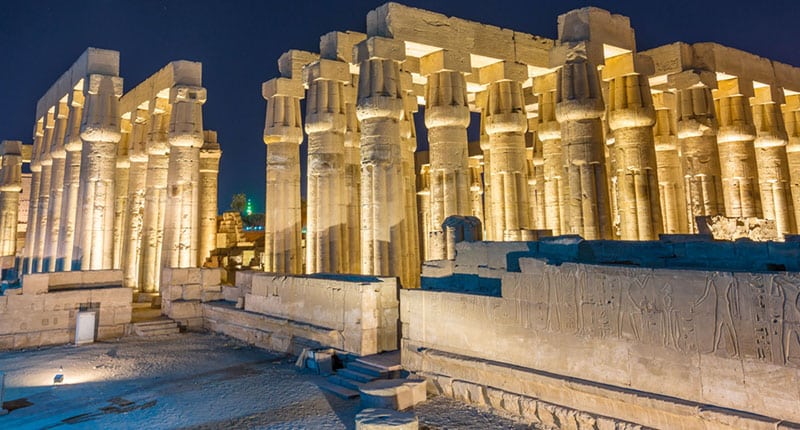
Luxor Temple, a captivating marvel nestled on the banks of the Nile River, stands as a testament to the grandeur of ancient Egyptian architecture and the rich history it embodies. This awe-inspiring structure has fascinated historians, archaeologists, and tourists alike, drawing them into a journey through time. Let’s embark on an exploration of the captivating history behind Luxor Temple and the stories it holds within its magnificent walls.
Nestled in the heart of the ancient city of Thebes, Luxor Temple boasts a history spanning over 3,000 years. It was constructed during the reign of Pharaoh Amenhotep III and continued to be embellished by subsequent pharaohs, each leaving their mark on its majestic walls.
The Significance of Luxor Temple
Luxor Temple held immense religious and political significance in ancient Egypt. It was dedicated to the great god Amun-Ra, the king of the gods, and served as the focal point of many religious ceremonies and festivals.
Construction and Architectural Marvels
The temple’s architectural brilliance lies in its colossal statues, towering obelisks, and intricately carved hieroglyphs that depict the triumphs and rituals of the pharaohs. The monumental pylon gateway and the hypostyle hall are architectural marvels that stand as a testament to ancient Egyptian engineering prowess.
Religious Practices and Rituals
Luxor Temple was not only a place of worship but also a site for elaborate rituals and ceremonies. The Opet Festival, a grand celebration of fertility and renewal, was held here annually, during which the sacred procession would carry statues of Amun, Mut, and Khonsu from Karnak Temple to Luxor Temple.
The Legacy of Pharaohs
Many pharaohs, including Tutankhamun, Ramses II, and Alexander the Great, left their mark on Luxor Temple through additions and inscriptions. The grandeur of these additions highlights the temple’s significance as a living record of ancient Egyptian history.
Cultural Influences and Artistic Expression
The temple’s walls are adorned with exquisite carvings and depictions that offer insights into the daily life, culture, and mythology of ancient Egypt. These intricate artworks provide a window into the beliefs and aspirations of the people of that era.
Rediscovery and Restoration Efforts
In more recent history, Luxor Temple experienced a rediscovery by European explorers. Restoration efforts have been ongoing to preserve its beauty and historical integrity, ensuring that future generations can continue to marvel at its splendor.
The Modern-Day Splendor
Today, Luxor Temple remains a UNESCO World Heritage site and continues to draw visitors from around the globe. Its breathtaking architecture and rich history make it a must-visit destination for anyone intrigued by the wonders of the ancient world.
Unveiling the Hidden Chambers
Recent archaeological discoveries have unveiled hidden chambers within Luxor Temple, shedding new light on its mysteries. These chambers provide clues about the temple’s function and the rituals performed within its walls.
Symbology and Mythology
The temple’s artwork is laden with symbolism and mythological references. From the sacred scarab beetle to the powerful sun god Ra, each element carries deeper meanings that offer insights into the beliefs of ancient Egyptians.
The Avenue of Sphinxes
Connecting Luxor Temple with Karnak Temple is the Avenue of Sphinxes, a grand pathway flanked by these mythical creatures. This avenue was used during religious processions, making it a living connection between the two majestic temples.
Luxor Temple: A Center of Festivals
Luxor Temple played a central role in numerous festivals that celebrated the deities and the pharaohs. These festivals were vibrant displays of culture, spirituality, and communal celebrations.
The Luxor Temple Sound and Light Show
One of the most enchanting ways to experience Luxor Temple is through the Sound and Light Show. This multimedia spectacle brings the temple’s history to life, narrating its tales against the backdrop of the illuminated ruins.
Preservation Challenges and Future
While Luxor Temple has stood the test of time, it faces preservation challenges due to environmental factors and tourism. Continued efforts are essential to ensure that this magnificent relic remains accessible for future generations to appreciate.
Conclusion
Intriguing and majestic, Luxor Temple stands as a living testament to the ingenuity, spirituality, and cultural richness of ancient Egypt. As we walk through its hallowed halls, we are transported to an era of grandeur and wonder, where the past intertwines with the present, inviting us to unravel the mysteries it holds.
FAQs
- Can visitors enter the hidden chambers of Luxor Temple? Unfortunately, access to the hidden chambers is restricted to archaeologists and researchers for preservation purposes.
- Is Luxor Temple the same as Karnak Temple? No, Luxor Temple and Karnak Temple are two distinct but connected temples. They were linked by the Avenue of Sphinxes.
- What is the best time to visit Luxor Temple? The early morning or late afternoon offers the best lighting for photography and a more comfortable visit due to milder temperatures.
- Are photography and videography allowed inside the temple? Yes, photography and videography are usually allowed, but it’s advisable to check with the authorities on-site.
- How long does the Luxor Temple Sound and Light Show last? The Sound and Light Show typically lasts around 1 hour and provides a mesmerizing overview of the temple’s history.
